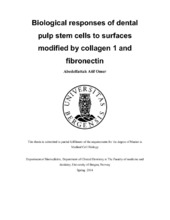Biological responses of dental pulp stem cells to surfaces modified by collagen 1 and fibronectin
Master thesis
Permanent lenke
https://hdl.handle.net/1956/8195Utgivelsesdato
2014-01-18Metadata
Vis full innførselSamlinger
Sammendrag
Collagen 1 and fibronectin are extracellular matrix proteins that contribute in cell activity and involve in regulating dental pulp stem cells. The purpose of this in vitro study was to investigate the effect of collagen 1 and fibronectin on the behavior of dental pulp stem cells. Material and Methods: Polystyrene multiwell culture plates were coated with collagen 1 and fibronectin according to the manufactures. Dental pulp stem cells (DPSCs) were isolated from third molar teeth of adult patients undergoing routine surgery at the Dental Clinic in the department of oral surgery at the Faculty of Medicine and Dentistry, University of Bergen, Norway. The cells were cultured and characterized using the following surface markers: Stro-1, CD90 and CD105. Characterization and analysis was performed using a flow cytometer. DPSCs were grown under three different conditions: collagen 1 coating, fibronectin coating and control group without coating. Cellular morphology and spreading were investigated by Crystal Violet staining under a normal light microscope at 1, 3 and 24 h. Cell attachment at 1, 3 and 24 h, and cell proliferation at 4 and 7 days were assessed using 3-(4,5-dimethyl-thiazoyl)- 2,5-diphenyl-tetrazolium assay (MTT) assay. Furthermore, the mRNA expressions of alkaline phosphatase (ALP), osteocalcin (OC), runtrelated transcription factor 2 (RUNX2) and bone morphogenic protein-2 (BMP-2) were determined after 7 days using real-time RT-PCR. The production RUNX2 by the cells cultured on the various plates was determined by Western Blot analysis. Furthermore, cell mineralization was assessed by ALP staining at day 7 and by Alizarin Red staining after 21 days of cultures. Results: In general, immunophenotypical characterization showed that, DPSCs expressed CD90 (24.4 %), CD105 (98 %) and STRO-1(7.3 %). Furthermore, DPSCs in osteoinductive media were able to differentiate into osteoblastic phenotype. The morphological analysis revealed no obvious difference on the shape of cells. Cells had spread well on both coated and non-coated culture plates with slight more spreading in the coated plates after 24 h. The MTT analysis did not demonstrate a significant difference at early time points among the groups but interestingly, the analysis disclosed more cells on the coated plates after longer cultures indicating a higher proliferative capacity in response to collagen 1 and fibronectin. RT-PCR, Western Blotting and mineralization assays did no revealed significant differences between the coated and non-coated surfaces in relation to osteogenic differential potential. Conclusion: In the present in vitro study, the isolated dental pulp cells expressed cell surface markers comparable to the expression from bone marrow mesenchymal stem cells and demonstrated osteogenic differentiation potential. Our data revealed that fibronectin and collagen 1 were able to promote cellular proliferation.
